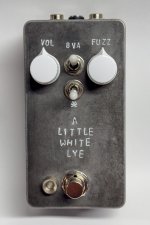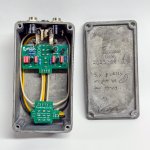Bricksnbeatles
Member known well
- Build Rating
- 5.00 star(s)
Demo pending— I was holding off on posting build reports until I could get some demos together, but I have an art fair that I need to work on stuff for, and I can't find my interface.
So, when @BuddytheReow announced the Player Hater's Ball, it got me off my ass a bit and motivated me to build some stuff. I'm all about the aesthetics on my builds, so being confined to what was already in my inventory was a tough predicament– I couldn't do a new UV print, but I absolutely despise the durability (or lack thereof) of rattle can finishes and posca graphics. I was going through my backlog of PCBs when I found this one– a Fuzzdog Vintage Soda pcb, which lets you build the Devi Ever Soda Meiser, and with the flick of a switch, change it into a Vintage Fuzz Master (the only difference between the two is the orientation of the 2n2907).
I had previously built a heavily modified take on the SM/VFM in a 1590C enclosure a few years ago with a BMP tone stack, and foot switches for chaos, feedback, and octave (SM/VFM) in addition to the bypass. It's a rat's nest due to all of the offboard wiring and excessive mods. Anyway, that was done up in a weathered, letter-punched enclosure, and I called it the Caustic Soda Fuzz. Finding the Vintage Soda pcb, I thought I'd make a junior successor to the Caustic Soda Fuzz, and I had the perfect name for it: A Little White Lye. For the chemically uninitiated, caustic soda (Sodium Hydroxide– NaOH) is one of the two forms of lye, alongside caustic potash (Potassium Hydroxide– KOH), but the joke probably won't be that funny to you if you need me to explain it.
I dug through my enclosure inventory, and found a Hammond 1590BS, which is the same footprint as a 1590B, but has a similar height to a 125B, which allowed me to do top jacks without moving the controls down to a hideously central location on the face of the enclosure. The enclosure was letter punched with all of the relevant markings, and then it went into a 'mystery potion' of white vinegar, salt, and steel wool for around 2 weeks to etch it up and make it look all weird and neat. The pictures really don't do it justice how cool it came out. The 'grain' of the cast aluminum was revealed in the process, and it's got a bit of a Beskar ingot vibe. I'll take some close up pics and add them when I get a chance. After that, it got a quick rub with some india ink to bring out the contrast of the etch a bit more, and then I filled the punched letters with white enamel paint, and wiped back with some OMS. As far as hardware goes, white 1400 style knobs, white rubber toggle switch caps, and a frosted (sanded with 1200 grit and then buffed with a white scotchbrite) cool-white LED round out the look.
As for the build itself, it's a simple one. Not really anything of note to say about the build process. I thought I had run out of coated wire (I found two spools of teflon coated 22awg that I bought from @StompBoxParts in 2022 right after finishing this one up), so I used cloth pushback wire on this one, and I gotta say, it's a joy to work with. Y'all might ask about the phrase written on the back plate (for the unaware, I write the build date and some sort of quote or phrase on the back of each of my builds), but that's a mystery for y'all to figure out.
Sound-wise, this pedal rips. Definitely my favorite Devi Ever circuit I've tried, and it's shockingly useable. Heavy as shit in the Soda Meiser mode, verging on synthiness at high gain settings, while feeling very Neil Young-ish in the first 60% of the pot's rotation. Flip the chaos switch (Labeled with an asterisk on the build) up and things get so much crazier– Falling apart like some Arc/Weld/Ragged Glory kind of shit. In the Vintage Soda Meiser mode, it's possibly the most octave-heavy octave fuzz I've played in a long time– just stay away from the chaos switch in that mode unless you like the shrillest possible tone that ducks on pick attack and blooms into feedback once your note decays away. Honestly a lot of fun, but definitely way too extreme for even most of my uses, though I will definitely feature it in my inevitable demo. I'm usually not a big Devi fan, but both primary modes of this circuit have a lot going for them. Highly recommended.



So, when @BuddytheReow announced the Player Hater's Ball, it got me off my ass a bit and motivated me to build some stuff. I'm all about the aesthetics on my builds, so being confined to what was already in my inventory was a tough predicament– I couldn't do a new UV print, but I absolutely despise the durability (or lack thereof) of rattle can finishes and posca graphics. I was going through my backlog of PCBs when I found this one– a Fuzzdog Vintage Soda pcb, which lets you build the Devi Ever Soda Meiser, and with the flick of a switch, change it into a Vintage Fuzz Master (the only difference between the two is the orientation of the 2n2907).
I had previously built a heavily modified take on the SM/VFM in a 1590C enclosure a few years ago with a BMP tone stack, and foot switches for chaos, feedback, and octave (SM/VFM) in addition to the bypass. It's a rat's nest due to all of the offboard wiring and excessive mods. Anyway, that was done up in a weathered, letter-punched enclosure, and I called it the Caustic Soda Fuzz. Finding the Vintage Soda pcb, I thought I'd make a junior successor to the Caustic Soda Fuzz, and I had the perfect name for it: A Little White Lye. For the chemically uninitiated, caustic soda (Sodium Hydroxide– NaOH) is one of the two forms of lye, alongside caustic potash (Potassium Hydroxide– KOH), but the joke probably won't be that funny to you if you need me to explain it.
I dug through my enclosure inventory, and found a Hammond 1590BS, which is the same footprint as a 1590B, but has a similar height to a 125B, which allowed me to do top jacks without moving the controls down to a hideously central location on the face of the enclosure. The enclosure was letter punched with all of the relevant markings, and then it went into a 'mystery potion' of white vinegar, salt, and steel wool for around 2 weeks to etch it up and make it look all weird and neat. The pictures really don't do it justice how cool it came out. The 'grain' of the cast aluminum was revealed in the process, and it's got a bit of a Beskar ingot vibe. I'll take some close up pics and add them when I get a chance. After that, it got a quick rub with some india ink to bring out the contrast of the etch a bit more, and then I filled the punched letters with white enamel paint, and wiped back with some OMS. As far as hardware goes, white 1400 style knobs, white rubber toggle switch caps, and a frosted (sanded with 1200 grit and then buffed with a white scotchbrite) cool-white LED round out the look.
As for the build itself, it's a simple one. Not really anything of note to say about the build process. I thought I had run out of coated wire (I found two spools of teflon coated 22awg that I bought from @StompBoxParts in 2022 right after finishing this one up), so I used cloth pushback wire on this one, and I gotta say, it's a joy to work with. Y'all might ask about the phrase written on the back plate (for the unaware, I write the build date and some sort of quote or phrase on the back of each of my builds), but that's a mystery for y'all to figure out.
Sound-wise, this pedal rips. Definitely my favorite Devi Ever circuit I've tried, and it's shockingly useable. Heavy as shit in the Soda Meiser mode, verging on synthiness at high gain settings, while feeling very Neil Young-ish in the first 60% of the pot's rotation. Flip the chaos switch (Labeled with an asterisk on the build) up and things get so much crazier– Falling apart like some Arc/Weld/Ragged Glory kind of shit. In the Vintage Soda Meiser mode, it's possibly the most octave-heavy octave fuzz I've played in a long time– just stay away from the chaos switch in that mode unless you like the shrillest possible tone that ducks on pick attack and blooms into feedback once your note decays away. Honestly a lot of fun, but definitely way too extreme for even most of my uses, though I will definitely feature it in my inevitable demo. I'm usually not a big Devi fan, but both primary modes of this circuit have a lot going for them. Highly recommended.



